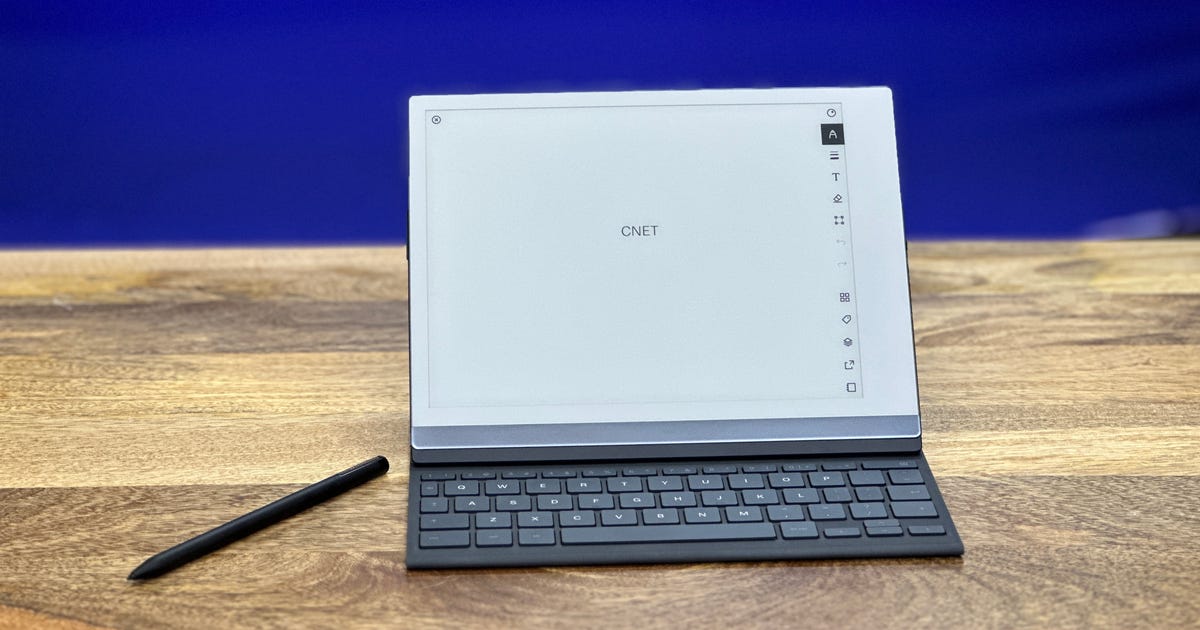It’s big, it’s powerful and it might arguably be from another planet. That’s an easy way to think about the Alienware m18, a new big-screen gaming laptop from Dell’s Alienware brand. Announced during CES 2023 in January, it’s already on the CNET testing bench and blowing me away with its massive display and top-shelf components.
That’s because Alienware sent one of the highest-end configurations possible, including an Intel Core i9-13980HX CPU and Nvidia GeForce RTX 4090 graphics card. Along with 32GB of RAM and a 1TB solid-state drive (the only choice that felt kinda skimpy), that means this exact build will cost $3,549. Note that prices and configuration options can shift in build-to-order systems like this. Also, the Core i9-13980HX isn’t listed as an available option just yet. Dell says it’s coming later in April.
If you’re more interested in the big screen than the big performance, the least expensive build of this system is currently $2,099, but includes only an Nvidia 4060 GPU, 16GB of RAM and a single 512GB SSD — a configuration that would cost much less in other gaming laptops.
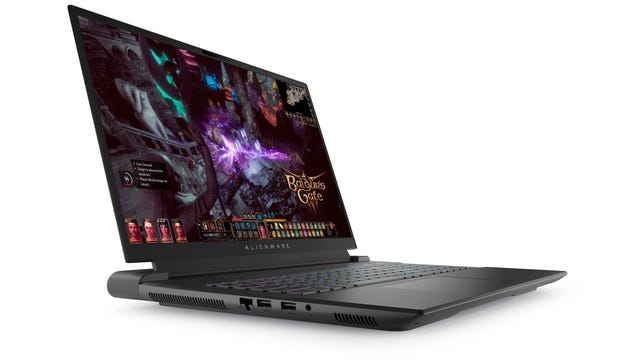
8.6
Alienware m18
$3,549 at Dell
Get Price Alerts
You’re receiving price alerts for Alienware m18
Like
- Massive screen for gaming
- Amazing performance from the Nvidia RTX 4090 GPU
- Tactile CherryMX keyboard
- Lots of ports and connections
- Less expensive than the other 18-inch gaming laptop we’ve reviewed
Don’t Like
- Blander color options than the previous generation
- Better components drive up the price
- Fans can get loud while gaming
This is not the only 18-inch gaming laptop of 2023. In fact, it’s not even the first one we’ve reviewed this year. That was the Razer Blade 18, which is very similar to this in overall look, feel, options and performance. While some may prefer the slightly less gamer-y design of the Razer, the version we reviewed cost $3,799 and only had an Nvidia 4080 GPU, not the 4090 found here. It’s $4,499 to jump up to a 4090 GPU in the Razer.
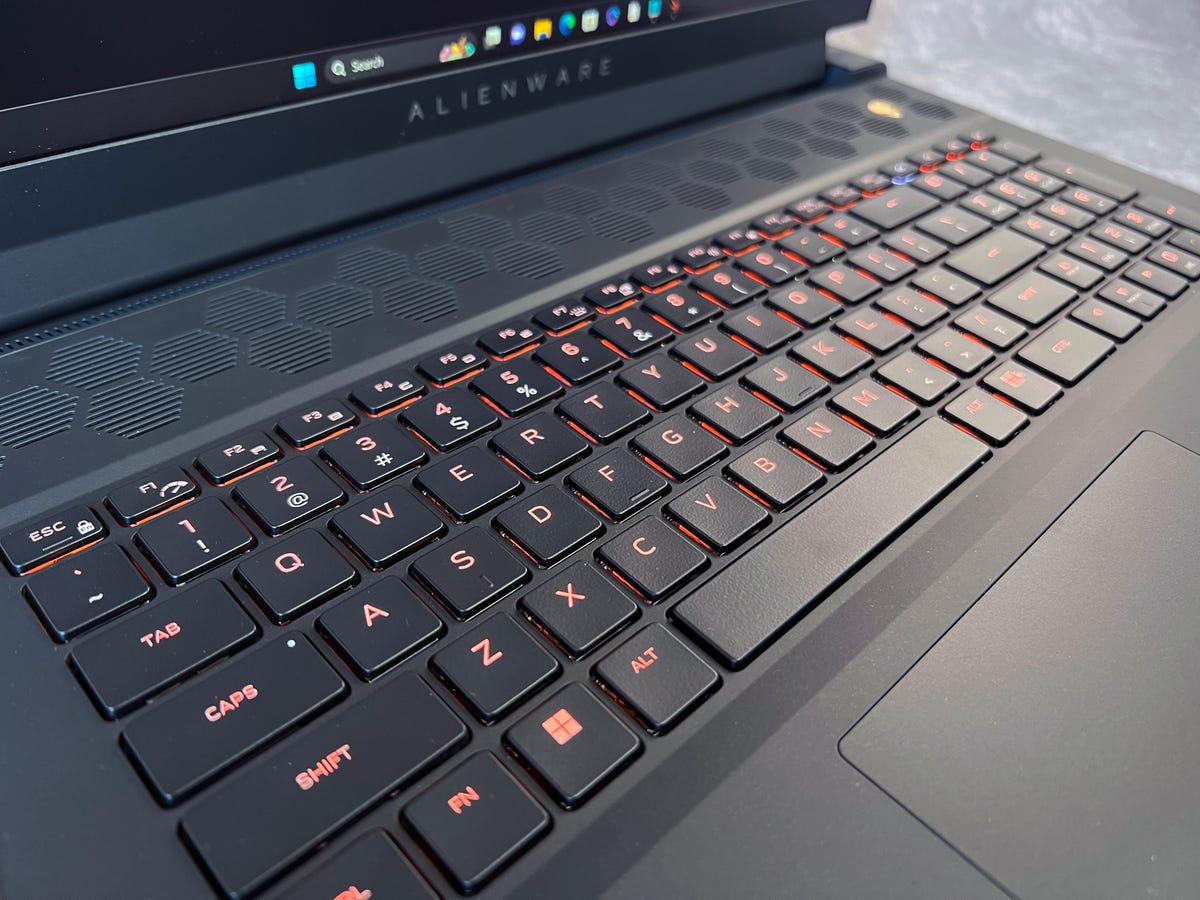

Per-key lighting is highly customizable.
Dan Ackerman/CNET
Unlike the relatively flat mainstream keyboard on the Razer Blade 18, the Alienware m18 has a CherryMX RGB keyboard with a hefty 1.8mm of key travel… and a very audible clack to its keys. Some people prefer this for adding to the desktop gaming keyboard feel. I find it distracting, but can see how you might like it.
Big-screen star
The screen is the big star here. There are two 18-inch options to choose from — a 2,560×1,600-pixel panel with a 165Hz refresh rate, and a 1,920×1,200-pixel one at a wild 480Hz. While pairing an Nvidia 4090 GPU with a 1200p screen seems like a waste, the super-fast refresh rate will appeal to competitive gamers who care more about insane frame rates than resolution.
As it is, in the 1600p version I tested I was able to crank new games up to their full graphics settings at full resolution and get great results. For Hogwarts Legacy, I ran everything on ultra settings, including the ray-tracing effects (which have been criticized for killing performance on other PCs) and still got a steady frame rate of at least 120 frames per second.
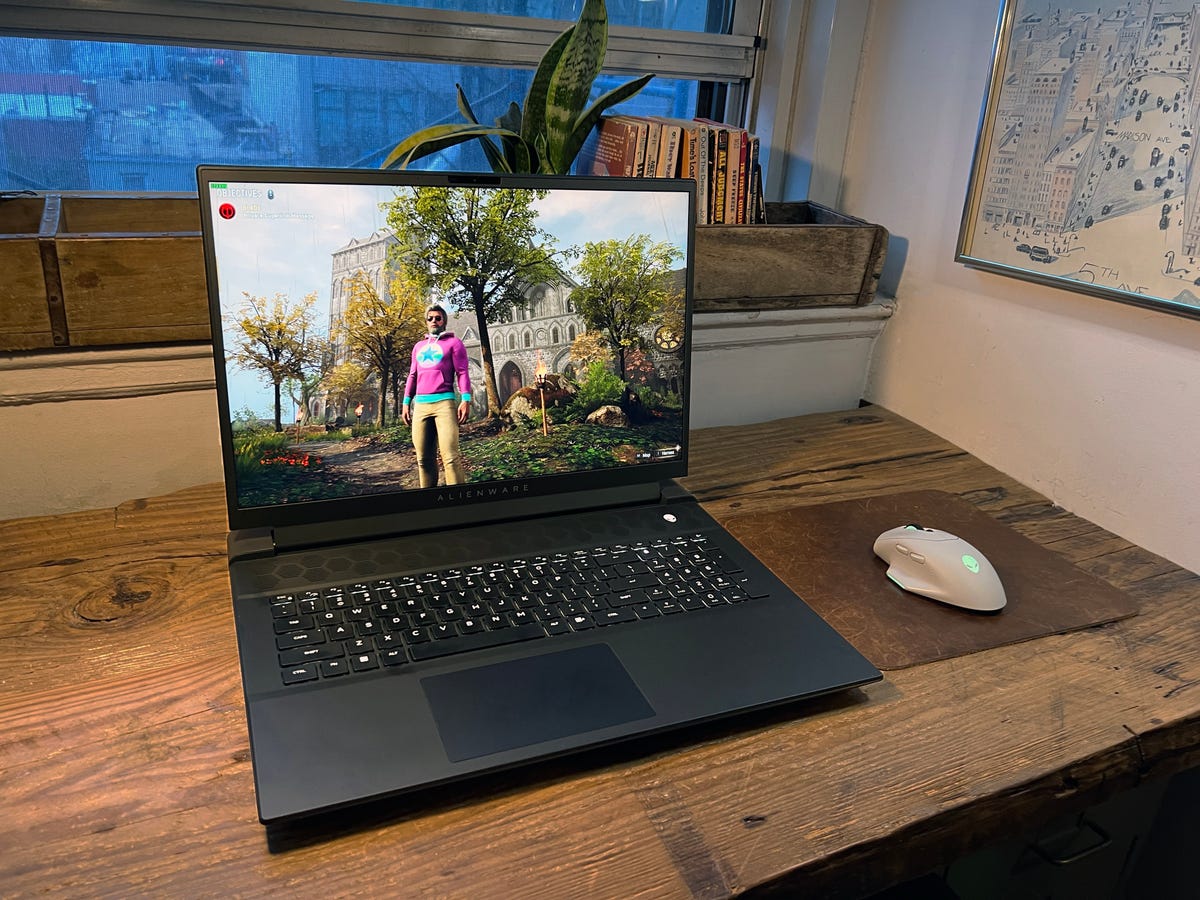

Dan Ackerman/CNET
Our other benchmarks were equally impressive, and the 4090 in this Alienware outmatched the 4080 in the Razer Blade 18 in every test. (Test results are at the end of this review.) So yes, this is the most powerful gaming laptop we’ve ever tested, but that’s always true of the latest and greatest, until the next hardware gen comes along.
Legendary look and feel
The latest revamp of the Alienware design language, called Legend 3.0, doesn’t reinvent much but makes some interesting tweaks. The rear panel is flatter, rather than slightly angled, and some small tweaks to the front lip make the system easier to open one-handed. There’s a new foot design underneath, basically a plastic riser that allows for decent airflow.
The 15-inch Alienware x15 R2 I reviewed last year ended up being one of my all-time favorite gaming laptops, and that was partly because of the great design and color palette. I really liked the retro-futurism of the matte white outer chassis. This time, the only option currently available is a near-black that Alienware calls dark metallic moon. It’s fine, but feels much more like a gaming laptop cliche than the previous color scheme. But if you like dark, brooding gaming laptops, you’re all set.
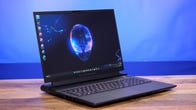

Now playing:
Watch this:
Alienware m18 Is a Massive 18-Inch Gaming Laptop
8:58
If you have an older Alienware machine, another interesting recent update is to the Alienware Command Center. That’s a proprietary software package that allows for fine-tuned controls of many system functions as well as performance monitoring.
The two big things you’ll probably use it for are jumping between performance presets and adjusting the per-key RPG lighting effects, which also extend to the alien head logos, a color border around the rear panel and even matching accessories like the new AW620M wireless mouse, a $99 accessory with 26,000 dpi tracking. Yes, it’s expensive, but it also carries over that matte white look I liked so much from last year.
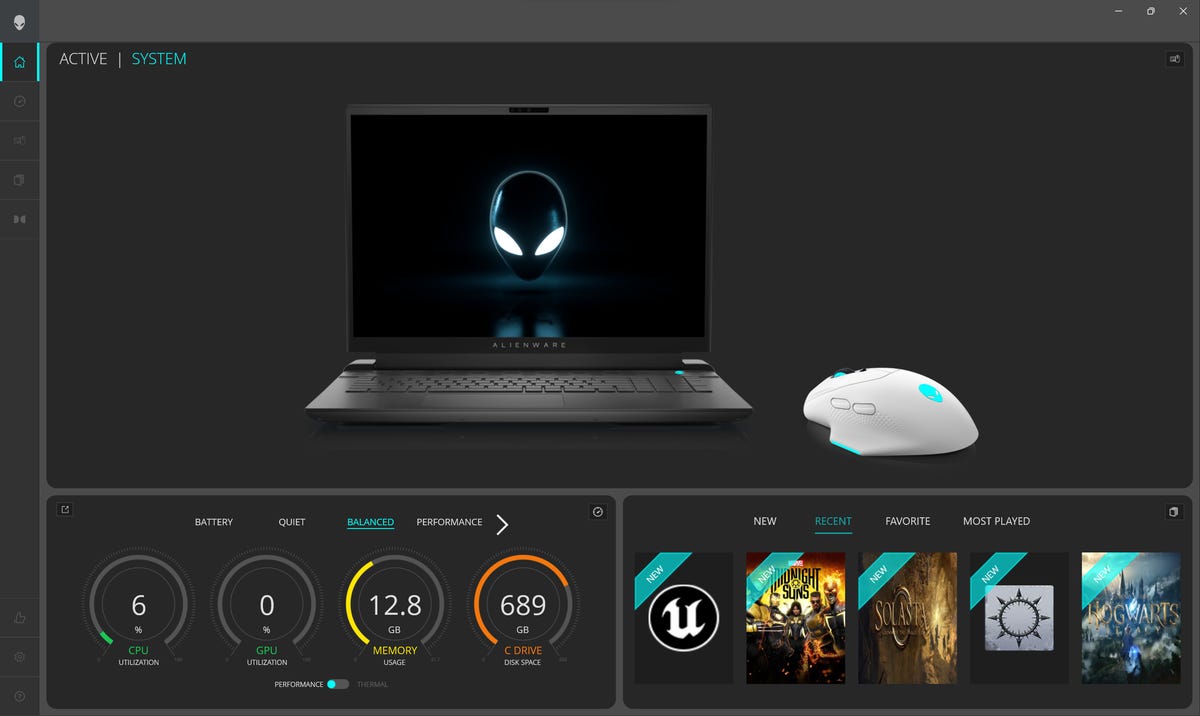

The Alienware Command Center software.
Screenshot by Dan Ackerman
The latest version of ACC is an improvement over older versions, which I always found unintuitive. Some functions, including for lighting control, are simpler and the entire app feels less cluttered.
If you’re going to play around with the performance presets, get ready for some fan noise and hot air. Presets include Battery, Quiet, Performance and Max, and by default the system can be set to jump into performance mode when a specific game (or any game) is launched.
A combination of quad internal fans, a vapor chamber and big heat pipes all help keep the system cool, and even running high-end games it doesn’t feel as fiery to the touch as the 15-inch Alienware x15 did. That said, hot air does blow out from vents on both sides and the rear, and I found my right hand getting hit with warm air when using a mouse relatively close to the system.
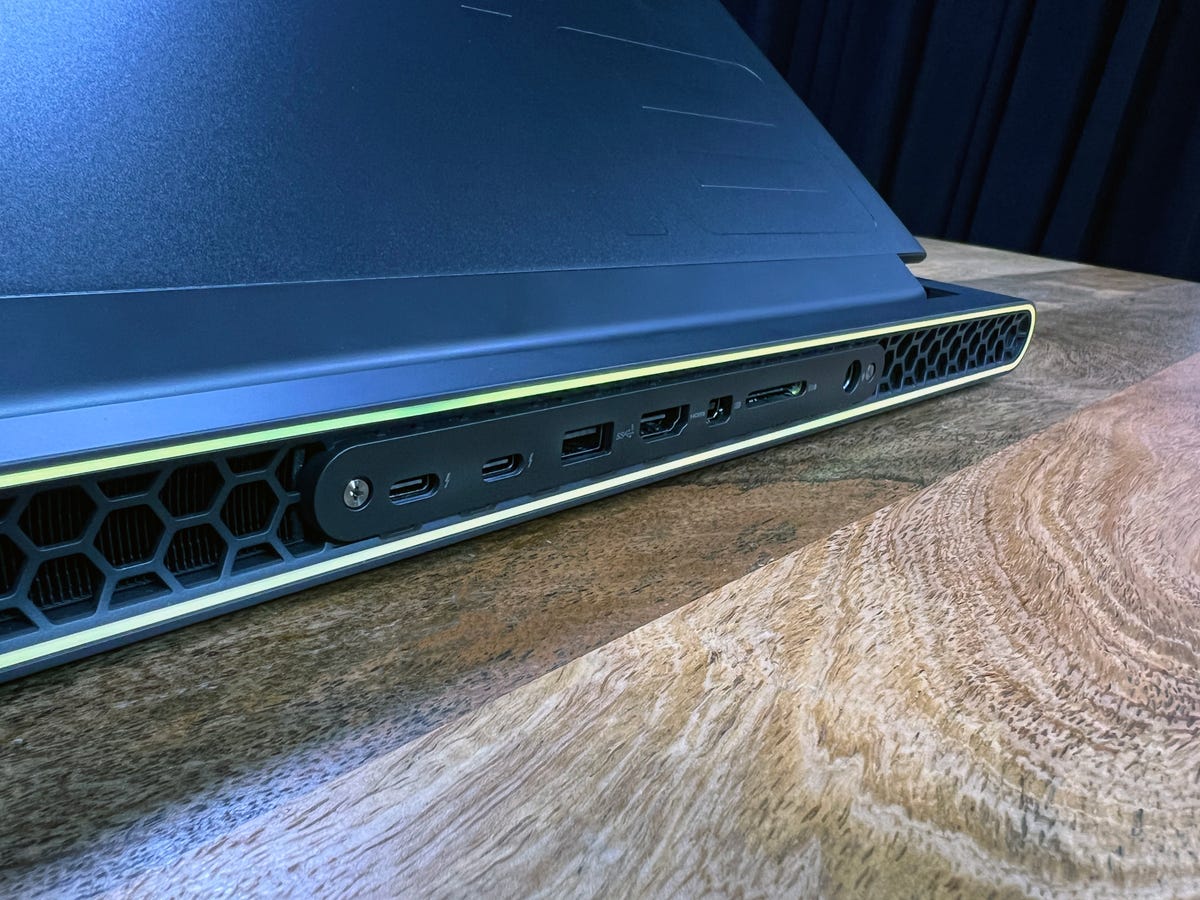

The rear panel holds many of the system’s ports.
Dan Ackerman/CNET
Another advantage of a big system like this is that there’s room for a lot of ports and connections. While some slim laptops are down to a couple of USB-C ports, this has almost everything you’d want. I’ll just list the ports below.
- 1x USB 3.2 Gen 1 port with PowerShare
- 4x USB 3.2 Gen 1 ports
- 2x Thunderbolt 4 Gen 2 Type-C
- 1x RJ45 Ethernet port
- 1x audio jack
- 1x HDMI 2.1 port
- 1x Mini DisplayPort
A big screen with a big body for all those ports, fans and other goodies is never going to be easy to lug around. I clocked the laptop itself at 8.7 pounds, and a total of 12 pounds including the power brick.
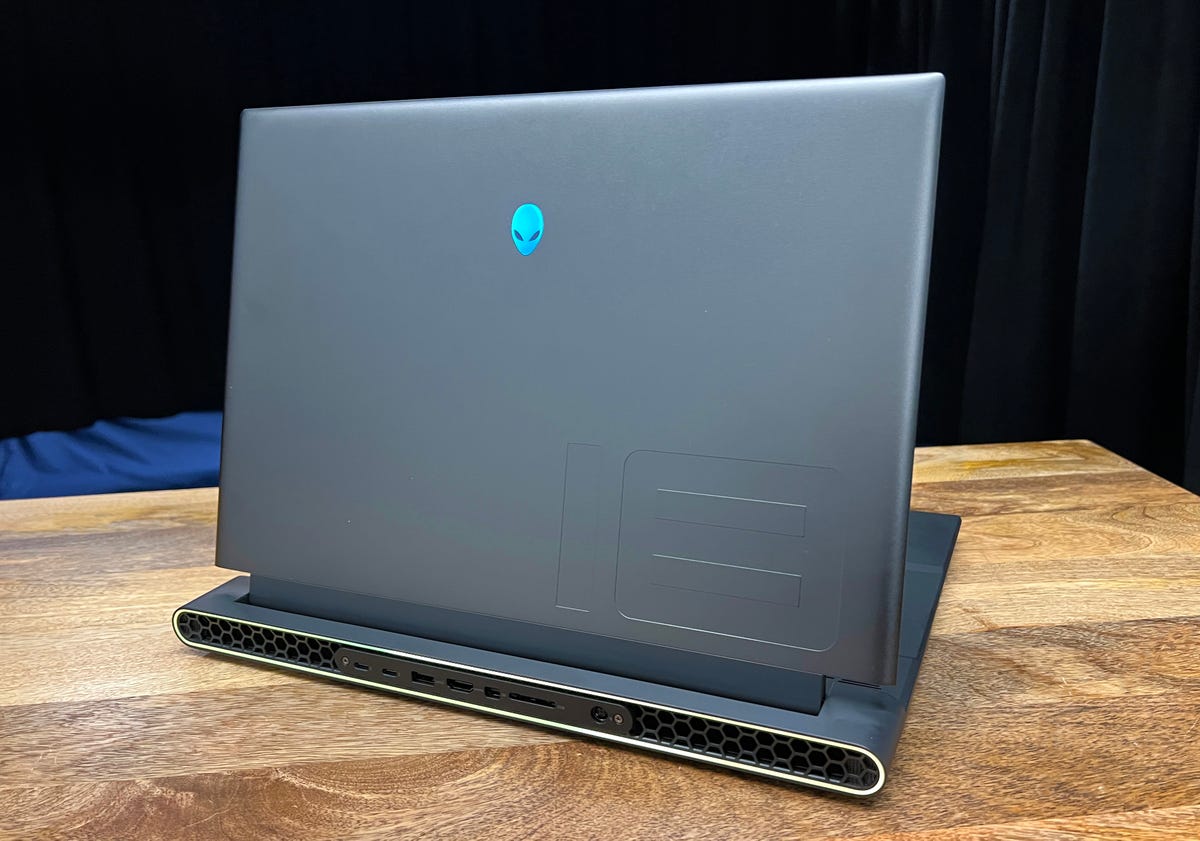

Dan Ackerman/CNET
Yes, this is a wildly expensive laptop with components far beyond the needs of mainstream gamers (or anyone who doesn’t want to spend $3K-plus on a laptop). That said, it feels like a bargain compared to the similar Razer Blade 18, so there’s an argument to be made that it’s really a very financially reasonable option. I’m not saying your spouse, parent or partner would agree with that argument, but it’s worth a shot.
Fun fact: This isn’t the first 18-inch gaming laptop from Dell. Back in 2013, I reviewed the then-new Alienware 18, a $4,000 monster that supported dual GPUs. The 18-inch design didn’t catch on back then, but I think it has a much better shot now.
Geekbench 5 (multicore)
Alienware m18 R1
20006
MacBook Pro (16-inch, M2 Pro, 2023)
15009
Razer Blade 18
13927
Acer Predator Triton 500 SE
13734
Origin PC Evo17-S
13170 Longer bars indicate better performanceNote:
3DMark Wild Life Extreme Unlimited
Alienware m18 R1
44500
Razer Blade 18
31176
Origin PC Evo17-S
25679
Acer Predator Triton 500 SE
20622
MacBook Pro (16-inch, M2 Pro, 2023)
12989 Longer bars indicate better performanceNote:
Guardians of the Galaxy (High @1,920×1,080)
Alienware m18 R1
202
Razer Blade 18
141
Acer Predator Triton 500 SE
138
Origin PC Evo17-S
135 Longer bars indicate better performanceNote:
The Riftbreaker GPU (1,920×1,080)
Alienware m18 R1
662.2
Razer Blade 18
405.19
Origin PC Evo17-S
289.01
Acer Predator Triton 500 SE
225.73 Longer bars indicate better performanceNote:
Cinebench R23 (multicore)
Alienware m18 R1
24899
Origin PC Evo17-S
17773
Acer Predator Triton 500 SE
17511
Razer Blade 18
16331
MacBook Pro (16-inch, M2 Pro, 2023)
14803 Longer bars indicate better performanceNote:
Online streaming battery drain test
MacBook Pro (16-inch, M2 Pro, 2023)
1474
Acer Predator Triton 500 SE
344
Origin PC Evo17-S
338
Razer Blade 18
307
Alienware m18 R1
249 Longer bars indicate better performanceNote:
System configurations
| Alienware m18 R1 | Microsoft Windows 11 Pro; 2.2GHz Intel Core i9-13980HX; 32GB DDR5 5,800MHz RAM; 16GB Nvidia GeForce RTX 4090; 1TB SSD |
|---|---|
| Razer Blade 18 | Microsoft Windows 11 Home; 2.2GHz Intel Core i9-13950HX; 32GB DDR5 5,600MHz RAM; 12GB Nvidia GeForce RTX 4080; 1TB SSD |
| Origin PC Evo17-S | Microsoft Windows 11 Home; 2.9GHz Intel Core i9-12900H; 32GB DDR5 4,800MHz; 16GB Nvidia Geforce RTX 3080Ti; 1TB SSD |
| Acer Predator Triton 500 SE | Microsoft Windows 11 Home; 2.9GHz Intel Core i9-12900H; 32GB DDR5 4,800MHz; 16GB Nvidia Geforce RTX 3080Ti; 1TB SSD |
| MacBook Pro (16-inch, M2 Pro, 2023) | MacOS Ventura 13.2; Apple M2 Pro (12 CPU cores, 19 GPU cores); 32GB LPDDR5 RAM; 1TB SSD |
How we test computers
The review process for laptops, desktops, tablets and other computer-like devices consists of two parts: performance testing under controlled conditions in the CNET Labs and extensive hands-on use by our expert reviewers. This includes evaluating a device’s aesthetics, ergonomics and features. A final review verdict is a combination of both objective and subjective judgments.
The list of benchmarking software we use changes over time as the devices we test evolve. The most important core tests we’re currently running on every compatible computer include: Primate Labs Geekbench 5, Cinebench R23, PCMark 10 and 3DMark Fire Strike Ultra.
A more detailed description of each benchmark and how we use it can be found in our How We Test Computers page.

